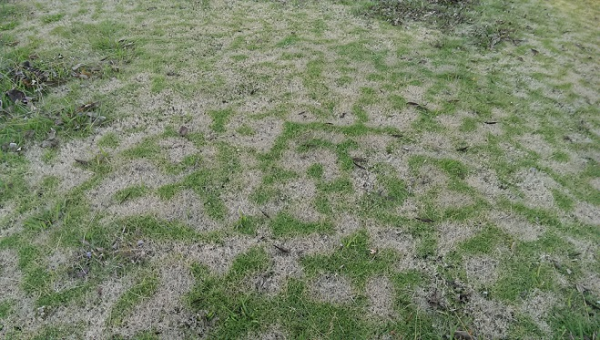Winter is on the Way!
As the days are cooling off and nights are getting colder, and we are soon to get a hard freeze! What does this mean for your lawn? First, you need to know and understand what kind of grass or grasses you have.
Do you see this pattern in your lawn? Don’t worry, it’s just frost damage. Frost damage does NOT actually damage your bermuda grass. Frost has just nudged a part of your grass into dormancy, hence the strange markings. Sometimes panicked customers will call us when they see this, thinking they have insects killing their lawn or a fungus or something. Relax! It’s normal.
As we head for winter and it gets colder, your bermuda lawn will go dormant. It will look brown. We always have some customers calling in a panic saying their lawns are dead. These are mostly people who moved here from more southern climates where the bermuda grass or St. Augustine grass stays green year round.
Technically, the weather in our area is too cold for bermuda, a warm season grass, to stay green all year.
Some people also wonder why we’re treating brown grass at the beginning of the year. But while the bermuda grass looks brown, it’s not dead, and its root system is still active. The pre-emergent application we are putting on bermuda grass is very important this time of year because it prevents crabgrass from germinating. If you don’t have a crabgrass pre-emergent put on your lawn, crabgrass will be very hard to control during the summer.
FESCUE GRASS – in the shade
If you have fescue grass in your shady areas, it should be green and doing well right now, because it’s a cool season grass. Hopefully, you have overseeded it to keep it thick and healthy.
Technically, the weather in our area is too hot for fescue, which is why we plant it in shade areas, because bermuda grass will not grow in the shade, and fescue grass will not thrive in the sun in the hot summer.
However, fescue really needs the sun to make food for itself through photosynthesis, and it will get sun as soon as the leaves are off the trees.
But, here’s the tricky part. The leaves will fall off the trees right onto your fescue grass, covering it up. It is essential that you try to keep the leaves blown off your fescue grass so it can get sun and store up carbohydrates to make it through the long hot summer next year.
Stay off of newly seeded areas until turf has been mowed once or twice. You can also set your mower at the highest setting and use it to vacuum up your leaves after seed has been established.
Do not mulch leaves on top of fescue, they must be bagged and removed.
Note: If you have fully shaded areas, such as between the house and the fence, or the fence line even fescue will struggle grow there. All grass needs some sun.
Reach out to us for additional ideas on these areas.

